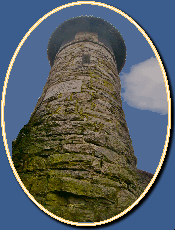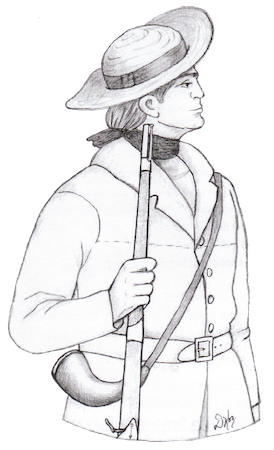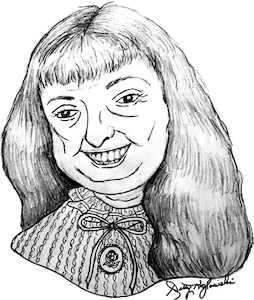Revolutionary War soldier; noted diarist
John Downs was a weaver, school teacher, and a member of the militia who fought with Connecticut forces on Long Island (Battle of Brooklyn Heights), Harlem Heights, New Haven and Fairfield and served as a Milford Minuteman (a form of home guard).
His biggest claim to fame is that he kept a diary for 47 years, from 1763 to 1810, recording every day weather observations and telling, in very few words, what he did that day. The diary provides picture of life in Milford during and after the American Revolution.
John Downs was born in Milford in June 1745, and he died in Milford on February 19, 1819, at age 74. He is buried in Milford Cemetery. He was the son of John Downs and Ann Hine. He married Hannah Stone on December 14, 1769. She was born in 1752 and died on December 27, 1819 at the age 67 and is buried next to her husband.
John and Hannah had seven children, six of whom survived to adulthood.
In Families of Early Milford, Conn., Susan Woodruff Abbott, Downs’ great-great-great-great granddaughter, describes the diary as follows (p. 230), “This diary is contained in one book, possibly done in sections and sewed together with linen thread, about 7 by 5 inches. The pages are carefully and neatly ruled and written in excellent hand and shows little degeneration in his later years. A line done every day includes always the weather, his attendance at church every Sunday and his activities in the town, which were many.”
The diary was passed down through the generations and is now at the library of the University of New Mexico at Albuquerque. This is because the woman who inherited the diary moved there and decided to present it to the university for safe keeping. A microfilm copy of the diary is in the Milford Public Library.
A typical entry when he was weaving would include, after a brief description of the weather, what kind of cloth he wove that day, for whom, and how much. The entry for October 5, 1775, for instance, reads, “rain most all Day, I wove Lieut Isaac Treats Lin[en] 8:0:0. The three numbers at the end of the line indicate yards, els (1/4 yard) and nails (about 2 inches).
Some entries could be poignant. During September 1773, we find the following entries,
16 Clear & pleasant, I Spooled & warp & Sized Got the Doctor
17 Clear & warm, I tended my Dear Son John with the Canker [scarlet fever]
18 Clear & pleasant, I help tend John & he very Sick
C Clear & good weather. I at home my Son John Died
20 Clear & warm, I prepared and Buried my Son
(Note: Downs’s son, John, was 2 ½-years-old when he died. The letter “C” for the 19th is a Dominical letter used in almanacs for Sundays, which Downs used consistently throughout his diary.)
At times Downs could be maddeningly terse with his comments on the news of the day. Three days after the fighting at Lexington and Concord in April 1775, his comment was, “a Sorrowful Alarm.” And, two days after this, “News from Boston.”
He frequently mentions training with the local militia, and finally he sees action. On August 13, 1776, he and the Milford men board Capt. Pond’s sloop for New York. He then tells of watching for the enemy and being on fatigue duty.
Then on the 27th the unit goes over to Long Island. On the 30th was the Battle of Long Island or Brooklyn Heights, at which the Americans were badly defeated. He says, “we quit our station & flee to New York.” But on the 16th of September, at Harlem Heights, “I join our Reg.t at the line & a Smart fight, we beat them back.”
Downs was discharged from the army on the 25th and returned to Milford on foot, marching six miles the first day. On the 26th he walked 33 miles almost to Norwalk, and reached home the following day and found all well. The next day he went out “a-squirreling & got 3 squirrels & 1 pigeon.”
Downs makes no mention of one of Milford’s most historic events, the last day in December 1776 when 200 American soldiers were cast on the shores of Milford by the British, about a quarter of whom were suffering from smallpox. But in March 1777 he journeyed to Salem, New York, to be inoculated for small pox. This gave him a severe case of the disease from which he almost died. There is a 10-day period when he made no diary entries because of “the small pox which was heavy upon me.”
Having contracted and recovered from the disease, he acquired an immunity that allowed him to later go to New Haven to tend sufferers during an epidemic.
His comment on the British raid at Pond Point on August 25, 1777, for which Abigail Merwin would be a Milford Hall of Fame 2011 co-inductee, again was terse, “Cloudy & rain, I at the farm, Alarm & Training at Town.”
In other military actions, Downs witnessed the British raid on New Haven in 1779 and then the burning of Fairfield.
The end of the Revolutionary War did provide cause for Downs to be more specific about the news. When word of Yorktown reached Milford, he wrote “rejoyce for Victory [over] Cornwallis.” And then, with word of the Treaty of Paris in 1783 ending the war, on March 31 “went to rejoice for peace.”
In addition to his weaving and militia duties, Downs was a part-time school teacher. In those days teaching duty was passed among various people on a rotating schedule. For instance, starting on February 4, 1784, “I begin School at Bryan Farm.” Bryans Farm would be North Milford or present-day Orange. Every day from then until March 27, the day’s entry except Sunday’s includes “I keep school.” As this appears to have been a rather lengthy commute, Downs tells of boarding with different families every few days.
John Downs’ house still stands at 139 North Street, having been saved from “demolition by neglect.” There is some uncertainty about when the house was built. The framing of the house is consistent with the techniques in use about 1750, but Downs tells of dismantling his old house and building a new one on his property during the 1790s.
There is much in the diary of everyday life in Milford during this period. Downs frequently tells of farming, “killing hogs,” haying, hoeing corn and helping his father-in-law, Samuel Stone, whom he refers to as “Father Stone.”
Downs regularly attended the Second Congregational Church, or “Plymouth” Church, and usually tells who preached each Sunday. As was the Puritan custom, he did not observe Christmas. He would mention what day it was but then tell of a normal work day.
Those who would like to know what life in Milford was like more than 200 years ago can get a vivid idea from reading Downs’ diary.



